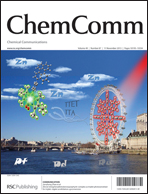Electron transport through 5-substituted pyrimidines in DNA: electron affinities of uracil and cytosine derivatives differently affect the apparent efficiencies†
Abstract
We investigated excess electron transport (EET) in DNA containing cytosine derivatives. By arranging the derivatives according to their electron affinities, the apparent EET efficiency was successfully regulated. Unexpectedly, however, providing gradients of electron affinity by inserting 5-fluorocytosine did not always enhance EET.


 Please wait while we load your content...
Please wait while we load your content...